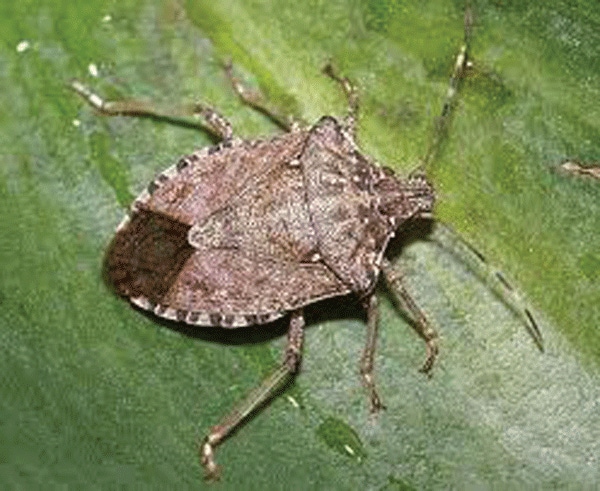
Brown marmorated stink bugs continue southward movement
Entomologists contend the southward movement of the brown marmorated stink bug is almost certain to continue.Virginia Tech Entomologist and IPM Leader Ames Herbert says brown marmorated stink bugs, sometimes called Asian stink bugs, have reached soybean fields in northern Virginia and appear to be moving from full-season to double-crop beans.
October 20, 2011

Brown marmorated stink bugs continue their gradual march to the south and seem to be enjoying the grain fields of northern Virginia.
Entomologists contend the southward movement is almost certain to continue.
Virginia Tech Entomologist and IPM Leader Ames Herbert says brown marmorated stink bugs, sometimes called Asian stink bugs, have reached soybean fields in northern Virginia and appear to be moving from full-season to double-crop beans.
In Maryland, veteran University of Maryland Entomologist Galen Dively says that is exactly what happened in Maryland.
Brown marmorated stink bugs thrive on tender seeds in the pods of immature soybeans. Once beans get more mature, the bugs start looking for a new food source and double-crop beans are often easy prey.
Dively, who has been working with insect pests of grain crops for better than 40 years says, “Brown marmorated stink bugs are the most dangerous pest I’ve seen.”
“In Maryland, this bug is becoming more abundant each cropping season. Populations this year are 5-10 times higher than last year,” he says. And, he adds, “we expect these stink bugs will be worse next year.”
Fellow University of Maryland Entomologist Paula Shrewsbury says apple growers in Maryland, Virginia and West Virginia have lost up to 80 percent of their crop due to damage from this pest. “Growers who have had family farms for multiple generations have told us their whole operation is in jeopardy from these stink bugs,” Shrewsbury says.
No one is exactly sure where these bugs will go next, but the best bet is more fertile grain and cotton fields to the south. Dively says heavy snowfall last winter in Maryland and northern Virginia provided a cozy environment for stink bugs and they emerged in the springtime ready and eager to feed on commercial grain crops.
The brown marmorated stink bug is a native of Asia, hence its’ common nickname Asian stink bug, and was first found in and around Allentown, Pa., in the early 2000s. It was mostly a problem for homeowners and gardeners for the first few years, but now seems destined to become a major pest of agricultural crops.
Though similar to its common cousins brown stink bugs, green stink bugs and Southern green stink bugs, the Asian version has some unique and troubling characteristics.
The native stink bugs tend to over-winter in wooded areas in and around agricultural fields. The Asian stink bugs have shown a propensity to over-winter in urban areas, specifically in very high populations in houses, sheds, barns and other structures. This trait alone has brought them notoriety in the popular press and has even captured the attention of a Pennsylvania congressman who has led a political charge to find answers to this growing pest.
Easy to find
Herbert says these critters are easy to see on soybean plants and easy to catch, but unlike their American stink bug cousins, Asian stink bugs have an amazing startle reflex. “They quickly drop to the ground when the plant they are on is disturbed. I can stop, move close to take a picture of one of these stink bugs, and it will fall off the leaf to the ground,” Herbert explains.
The startle reflex doesn’t mean much to farmers — at least not yet, but it makes life very frustrating for researchers trying to learn more about these pests. It makes setting an economic threshold for these bugs very difficult, Herbert notes.
Not only did brown marmorated stink bugs make their way to the upper Southeast, but they appear to have brought their favorite native habitat with them. BMSB are listed as an invasive insect species and the tree-of-heaven, also native to Asia, is listed as an invasive plant species.
Tree of heaven is now common throughout most of Virginia. In the areas of north-central Virginia where Asian stink bugs have caused damage to soybeans, this weed species is everywhere. Many of the soybean fields in Virginia that have been infested with the Asian stink bug are small, irregular shaped fields with tree of heaven growing right up to the field border.
“In some of the soybeans fields we’ve looked at up there, we can find damage in the field, go to the edge of the field and find a tree-of-heaven, tap a limb and dozens of the bugs fall out. Farmers have tried cutting the weed/tree down, but they sprout back out quickly,” Herbert says.
The veteran Virginia Tech Entomologist adds that getting rid of tree-of-heaven wouldn’t likely do much to stop the southern movement of Asian stink bugs. These insects have hundreds of hosts, and though they do seem to prefer the tree-of-heaven, there are plenty of other plant hosts that suit them well.
Despite all the hoopla about the brown marmorated stink bug, it is not a super bug, according to Herbert.
There is no doubt it is a serious pest that needs a lot of attention, but many of the insecticides we have in our arsenal will kill it. The problem is populations build back up very quickly, and we don’t seem to be getting much residual activity from the insecticides we’re using to control them, he adds.
One management strategy that seems to be working in north-central Virginia is treating the field edges, up to 30-40 feet in from border areas. Herbert says that damage to soybeans has been largely restricted to the outer rows of a soybean field. Treating and re-treating these areas seems to be holding up as far as controlling populations found in these bean fields.
Strategy may not hold up
A big caveat is that this area of Virginia isn’t a large soybean producing area, creating some doubts this strategy will hold up, if these bugs move farther south into larger fields in areas where soybean production is more widespread.
Though researchers in Virginia and North Carolina are just now getting geared up for wide-scale studies of the brown marmorated stink bug, one characteristic is particularly troublesome. Initial studies indicate these pests pack a much bigger damage punch on soybeans.
Herbert says early tests indicate these insects create more puncture wounds per seed pod than do commonly occurring native stink bugs.
“Fortunately, the part of our state in which these bugs have attacked soybeans isn’t in an area with lots of soybeans. However, where we have found them in soybeans, the damage has been significant, and it appears bug for bug the Asian stink bug packs a bigger punch,” Herbert says.
The Virginia researcher got an early introduction to the brown marmorated stink bug via some research done by former graduate student Amanda Kopple. Though some of her work with parasitic wasps looked promising for managing brown marmorated stink bugs, Herbert says so far researchers have made little progress in finding a biological management tool for the new pest.
Though the Asian stink bugs are already an economically damaging pest, the potential for damage is enormous if it continues to move southward.
For starters, it’s over-wintering capabilities could be enhanced as it moves into a climate more typical of its native habitat in China.
A potentially devastating problem with the southward movement of the Asian stink bug is the Southeast’s cotton crop. Damage in home gardens shows okra to be a favorite host crop for these bugs and okra is closely kin to cotton.
Another potential cropping disaster, Herbert contends, is with pecans. We suspect these bugs will feed on pecans and they have the ability to penetrate immature nuts. Managing a pest like this in pecan trees would be a real nightmare, he notes.
For farmers in Virginia and the Carolinas, perhaps the best news is these imported stink bugs have definitely caught the attention of entomologists. As a group, Virginia-Carolina entomologists have a good track record of working together to find economically desirable management methods for a wide-ranging number of insect pests.
The brown marmorated stink bug is a real pest, but it may have a hard time coping with the array of management tools about to be thrown at it.
About the Author(s)
You May Also Like





